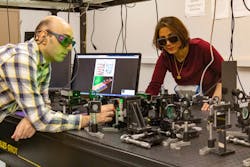Supersymmetric coherent laser beam combination produces high-quality beam
Researchers from the University of Central Florida (UCF; Orlando, FL) have overcome a long-standing problem in laser science—how to coherently combine many laser beams to produce a single high-quality beam—and the findings could have applications in surgery, drilling and 3D laser mapping.1
They have developed the first supersymmetric laser array. Supersymmetry is a conjecture in physics that says every particle of matter, such as an electron, has one or more superpartners that is the same except for a precise difference in their momentum.
"This is the first demonstration of a supersymmetric laser array that is promising to meet the needs for high power integrated laser array with a high-quality beam emission," says study co-author Mercedeh Khajavikhan, an associate professor of optics and photonics in UCF's College of Optics and Photonics. The resulting array emits exclusively in the fundamental transverse mode.
Khajavikhan says that earlier work by Demetrios Christodoulides, a UCF professor of optics and photonics and study co-author, suggested the use of supersymmetry in optics and her team has explored it further in its studies.
"However, it is only recently that my group managed to bring these ideas in actual laser settings, where such notions can be fruitfully used to address real problems in photonics," she says. The key is to space lasers apart in the array at dimensions found using calculations that take into account supersymmetry, resulting in the proper amount of coupling between the lasers.
Use in high-power arrays, lidar
In addition to high-power laser arrays, another possible application is lidar. "Lidar requires a high-power and high-beam quality laser," Khajavikhan says. "Currently, because of the lack of this type of lasers in integrated form, they use other kinds of lasers. The supersymmetric laser provides an integrated high-power laser solution that also shows high beam quality."
Co-authors of the study include Mohammad P. Hokmabadi, the study’s lead author and a postdoctoral associate in the College of Optics and Photonics; Nicholas S. Nye, a graduate research assistant in the college; and Ramy El-Ganainy, an associate professor at Michigan Technological University and a UCF alumnus.
Source: https://today.ucf.edu/ucf-researchers-develop-first-supersymmetric-laser-array/
REFERENCE:
1. Mohammad P. Hokmabadi et al., Science (2019); doi: 10.1126/science.aav5103.
About the Author
John Wallace
Senior Technical Editor (1998-2022)
John Wallace was with Laser Focus World for nearly 25 years, retiring in late June 2022. He obtained a bachelor's degree in mechanical engineering and physics at Rutgers University and a master's in optical engineering at the University of Rochester. Before becoming an editor, John worked as an engineer at RCA, Exxon, Eastman Kodak, and GCA Corporation.

